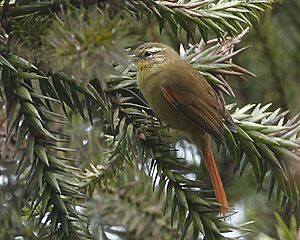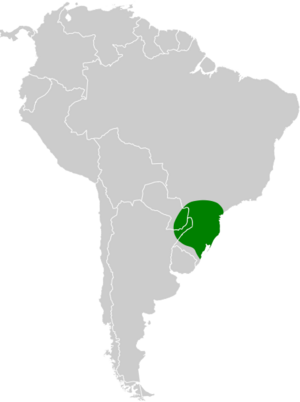Olive spinetail facts for kids
Quick facts for kids Olive spinetail |
|
|---|---|
 |
|
| Conservation status | |
| Scientific classification | |
| Genus: |
Cranioleuca
|
| Species: |
obsoleta
|
 |
|
The olive spinetail (Cranioleuca obsoleta) is a small bird that lives in parts of South America. It belongs to the ovenbird family, which is known for building unique nests. You can find this bird in Argentina, Brazil, and Paraguay.
Contents
About the Olive Spinetail
The olive spinetail is a special kind of bird. It is considered monotypic, which means it is the only species in its group. It is closely related to two other spinetail birds: the stripe-crowned spinetail and the pallid spinetail. Sometimes, the olive spinetail and the stripe-crowned spinetail even have babies together in southern Brazil.
What the Olive Spinetail Looks Like
The olive spinetail is a small bird, usually about 12.5 to 15 centimeters (5 to 6 inches) long. It weighs around 12 to 16 grams (0.4 to 0.6 ounces), which is about the weight of a few paper clips!
Both male and female olive spinetails look the same.
- They have a whitish stripe above their eye, called a supercilium.
- Behind their eye, there is a dull brown band.
- Their cheeks have buff and brown streaks.
- The area below their eye is plain buff.
- Their forehead has brown and buff streaks.
- The top of their head is a dull brownish-olive color.
- Their back and rump are a slightly richer brown.
- Their tail is a reddish-brown color. The tail feathers are spiky because they don't have soft edges at the end.
- Their wings are dark reddish-brown.
- Their throat is whitish.
- Their chest is brownish-buff.
- Their belly is a pale olive-buff.
- Their sides and the feathers under their tail are a bit darker.
- Their eyes can be different colors.
- Their beak is dark on the top and pinkish or grayish on the bottom with a dark tip.
- Their legs and feet are grayish-olive or olive-green.
Young olive spinetails look a bit darker than adults and might have some patterns on their chest.
Where the Olive Spinetail Lives
The olive spinetail lives in southeastern Brazil, eastern Paraguay, and northeastern Argentina. It likes to live in humid forests, both old-growth forests (called primary) and forests that have grown back (called secondary). It also likes woodlands where Araucaria trees grow. You can find these birds from areas near the sea up to about 1,000 meters (3,300 feet) high in the mountains.
Olive Spinetail Behavior
Movement
The olive spinetail stays in the same area all year round. It does not migrate to different places.
Feeding Habits
The olive spinetail eats small creatures like arthropods (which include insects and spiders). It usually hunts for food in pairs. Sometimes, it joins groups of different bird species that are feeding together. This bird is very good at moving around. It can climb and hitch along tree trunks and small branches. It finds its food by picking prey off bark, moss, and plants that grow on other plants (called epiphytes). It mostly looks for food in the middle part of the forest, but sometimes it goes up to the very top of the trees.
Reproduction and Life Cycle
The olive spinetail probably has its babies during the spring and summer months in the southern part of the world. Eggs have been seen in October. Scientists think that these birds stay with one partner for life. Their nest is believed to be a ball made of moss with an opening on the side. Not much else is known about how they raise their young.
Sounds and Calls
The olive spinetail has a special song. It starts with a high, hesitant sound like "tzit-tzit-tzit." Then it makes a short, high trill that ends with "sfeet-sfeet-sfeet." Its calls include a short "tst" sound and a quick, dry trill.
Conservation Status
The IUCN (International Union for Conservation of Nature) has listed the olive spinetail as a species of "Least Concern." This means that it is not currently in danger of disappearing. It lives in a large area, but scientists don't know exactly how many olive spinetails there are. They believe the population might be getting smaller.
Even though it's not in immediate danger, there are some things to consider. It is generally common in most places, but it is rare in Paraguay. It also lives in a few protected areas. However, its home range is relatively small, and a lot of its forest habitat has been cut down.


